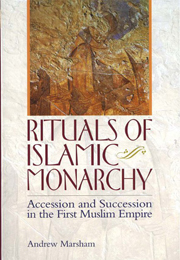Book contents
- Frontmatter
- Contents
- List of maps and figures
- Acknowledgements
- Map 1
- Map 2
- Map 3
- INTRODUCTION
- PART I LATE ANTIQUE ARABIA AND EARLY ISLAM (c. 550–c. 660)
- PART II THE UMAYYAD CALIPHATE (c. 660–750)
- INTRODUCTION
- 4 SUFYANID ACCESSION AND SUCCESSION, c. 660–683
- 5 THE OATH OF ALLEGIANCE IN THE EARLY TRADITION AND POETRY, c. 680–c. 710
- 6 THE MARWANID PATRIMONY AND DYNASTIC SUCCESSION
- 7 MARWANID RITUALS OF ACCESSION AND SUCCESSION
- 8 WRITING AND THE BAYcA IN THE MARWANID PERIOD
- 9 THE QURANIC CONTENT OF THE MARWANID DOCUMENTS
- PART III THE EARLY ABBASID CALIPHATE (c. 750–809)
- PART IV THE MIDDLE ABBASID CALIPHATE (809–865)
- CONCLUSION
- Genealogical table of Quraysh
- Genealogical table of the Abbasid caliphs
- Bibliography
- Index
5 - THE OATH OF ALLEGIANCE IN THE EARLY TRADITION AND POETRY, c. 680–c. 710
from PART II - THE UMAYYAD CALIPHATE (c. 660–750)
Published online by Cambridge University Press: 05 September 2013
- Frontmatter
- Contents
- List of maps and figures
- Acknowledgements
- Map 1
- Map 2
- Map 3
- INTRODUCTION
- PART I LATE ANTIQUE ARABIA AND EARLY ISLAM (c. 550–c. 660)
- PART II THE UMAYYAD CALIPHATE (c. 660–750)
- INTRODUCTION
- 4 SUFYANID ACCESSION AND SUCCESSION, c. 660–683
- 5 THE OATH OF ALLEGIANCE IN THE EARLY TRADITION AND POETRY, c. 680–c. 710
- 6 THE MARWANID PATRIMONY AND DYNASTIC SUCCESSION
- 7 MARWANID RITUALS OF ACCESSION AND SUCCESSION
- 8 WRITING AND THE BAYcA IN THE MARWANID PERIOD
- 9 THE QURANIC CONTENT OF THE MARWANID DOCUMENTS
- PART III THE EARLY ABBASID CALIPHATE (c. 750–809)
- PART IV THE MIDDLE ABBASID CALIPHATE (809–865)
- CONCLUSION
- Genealogical table of Quraysh
- Genealogical table of the Abbasid caliphs
- Bibliography
- Index
Summary
For all that the ‘Maronite Chronicle’ attests to some of the details of Mucāwiya's accession in Jerusalem in c. 660, there is no evidence for what was actually said at the Temple Mount, nor, beyond a hostility to the imposition of dynastic succession, does the later Arabic–Islamic tradition tell us with any verifiable accuracy what was pledged to Yazïd in c. 670 and reaffirmed in 680. From after the turn of the century, the evidential situation begins to improve. There is good evidence that some of the earliest extant versions of Islamic legal traditions (ḥadīth) took shape in the early eighth-century (although they are now extant only in ninth-and tenth-century compilations). When read alongside contemporaneous poetry from the early Marwanid court, and from the Marwanids' opponents, a consistent picture of the late-seventh and early eighth-century pledge of allegiance emerges. Nomads and former nomads, having made an emigration (hijra) to a garrison for jihad, were bound by pledges to obey their leader and not to ‘desert’, ‘revert to nomadism’ or ‘apostatize’ (tacarraba, irtadda, irfaḍḍa). Those who violated this pledge were ‘throwers-off’ of allegiance (khulacāɔ), outside ‘protection under covenant’ (jiwār, dhimma), without rights and potentially liable to execution. Both the legal traditions and the poetry also emphasise the monotheist and soteri-ological basis of the pledge: death without a bayca is a ‘pagan’, or jāhilī, death; indeed, for the Kharijite rebels against the caliphs the bayca is very explicitly a ‘sale’ of one's life in jihad.
- Type
- Chapter
- Information
- Rituals of Islamic MonarchyAccession and Succession in the First Muslim Empire, pp. 96 - 112Publisher: Edinburgh University PressPrint publication year: 2009



